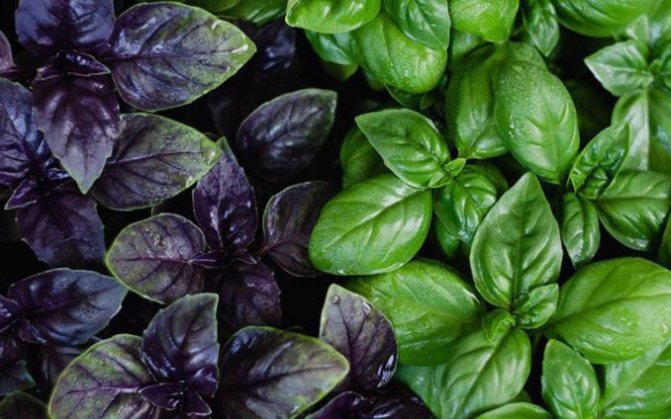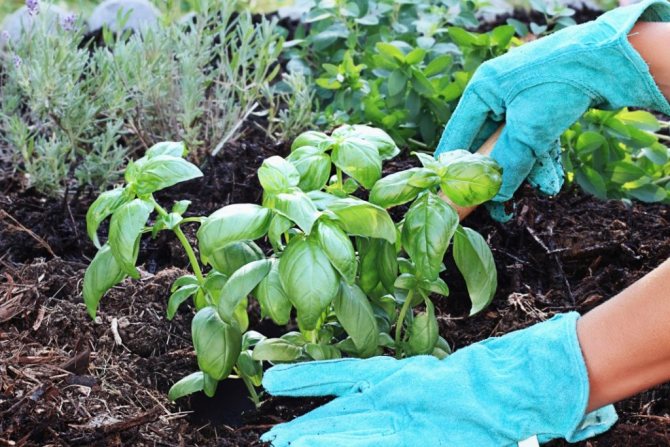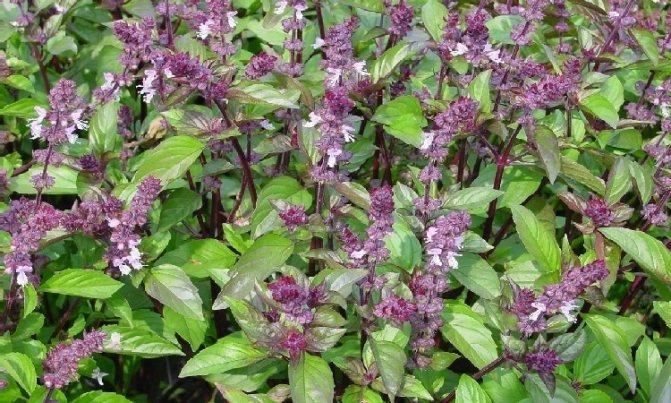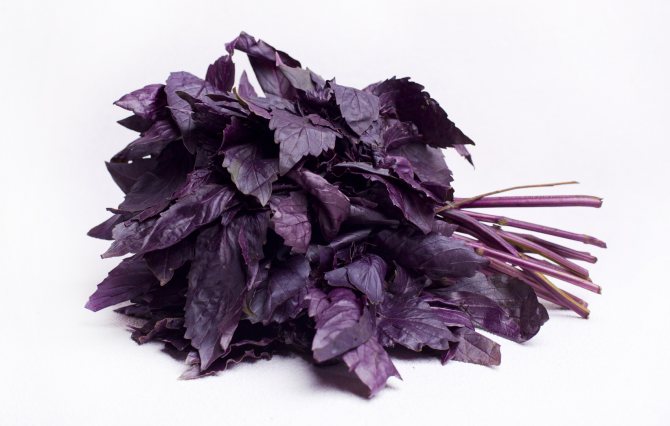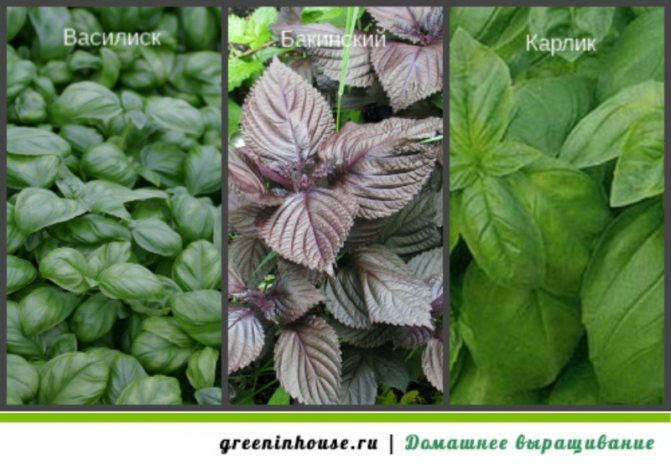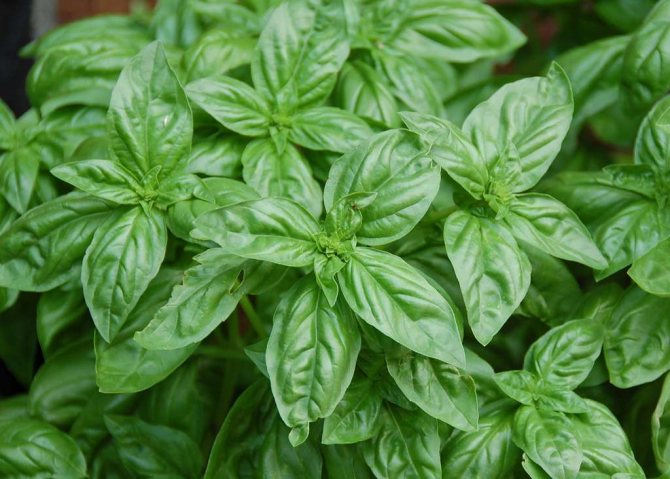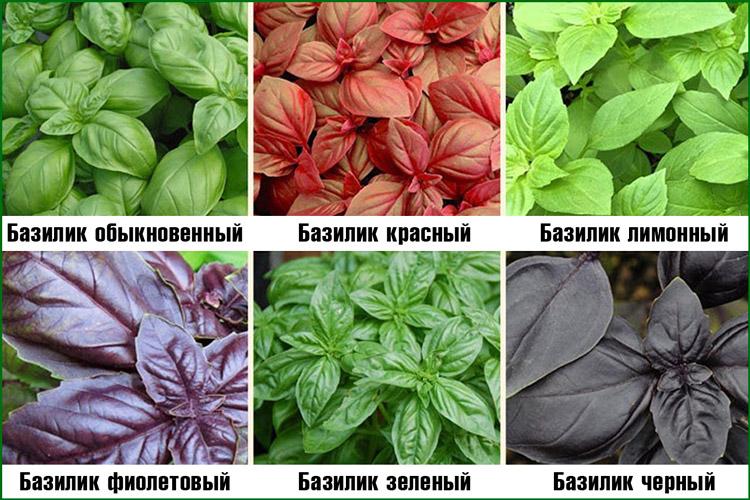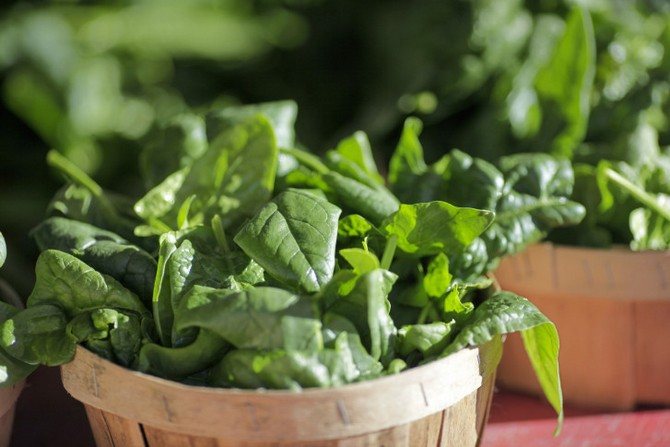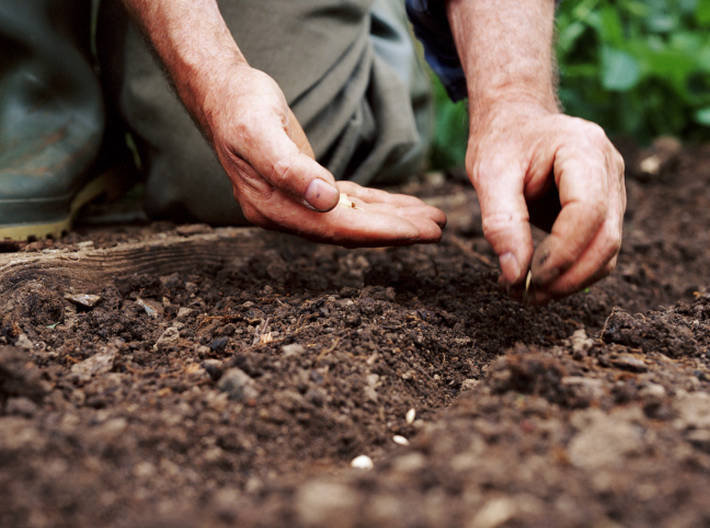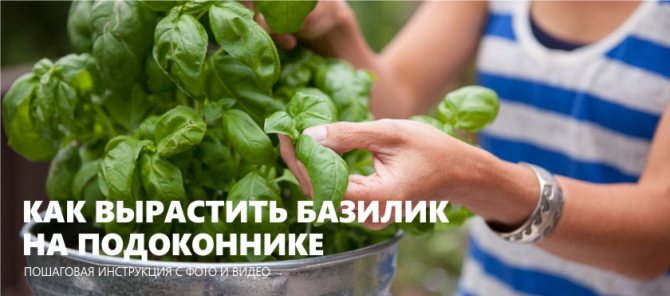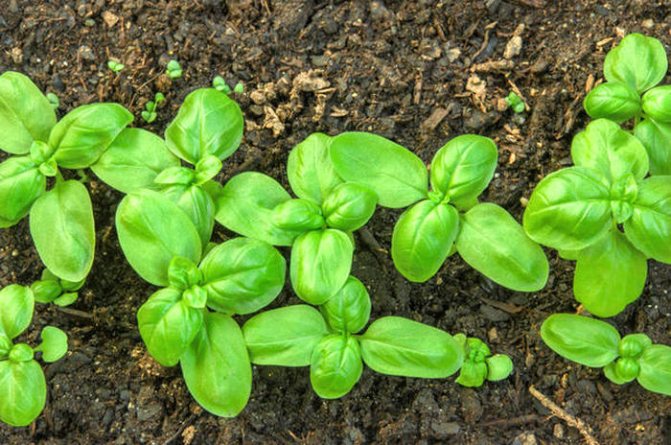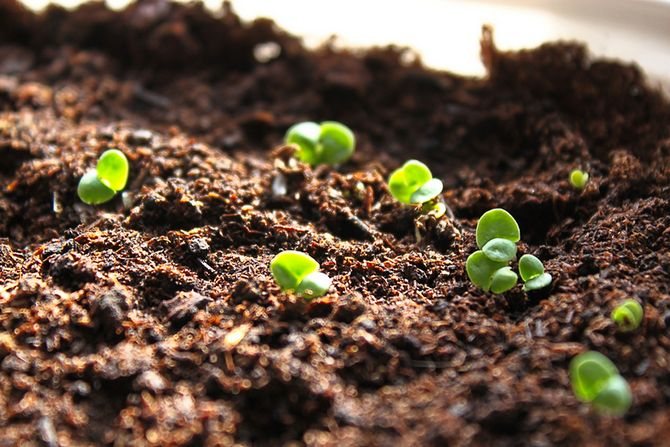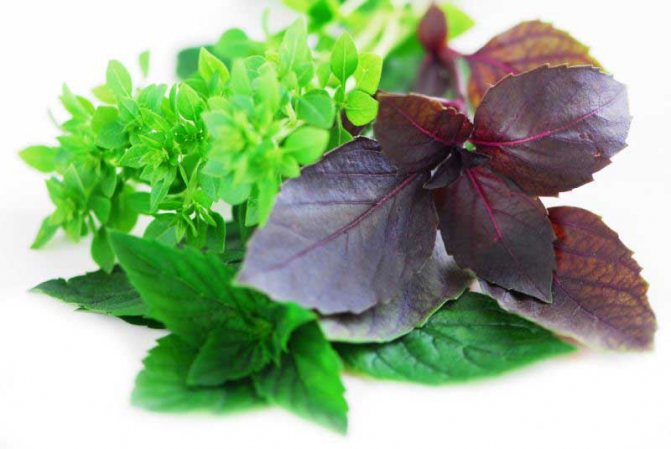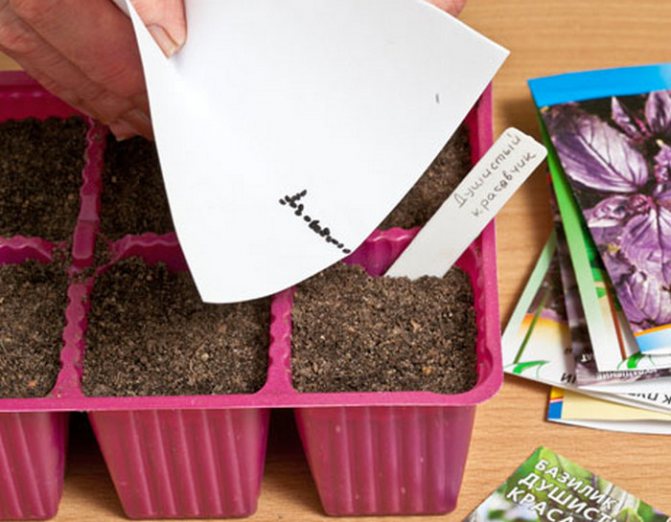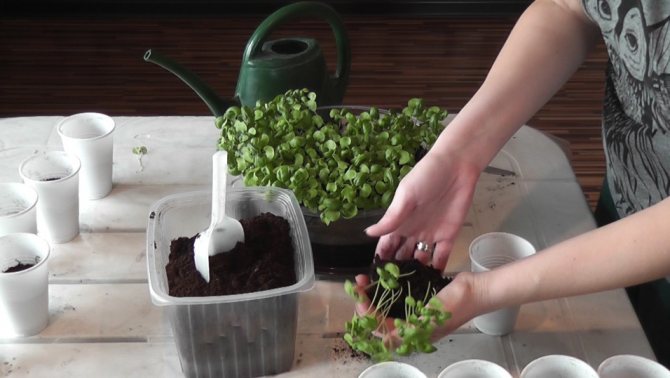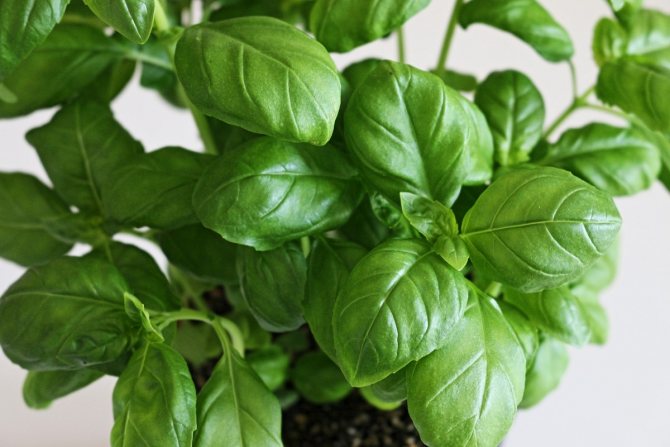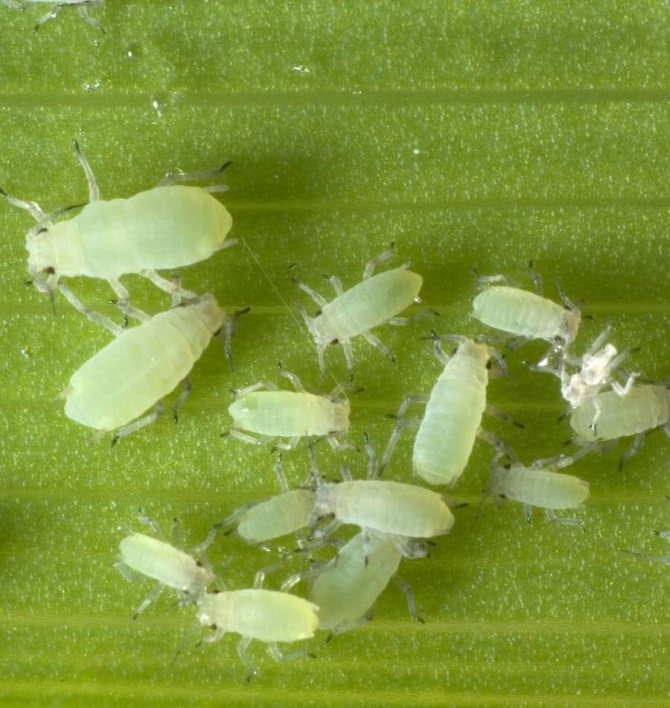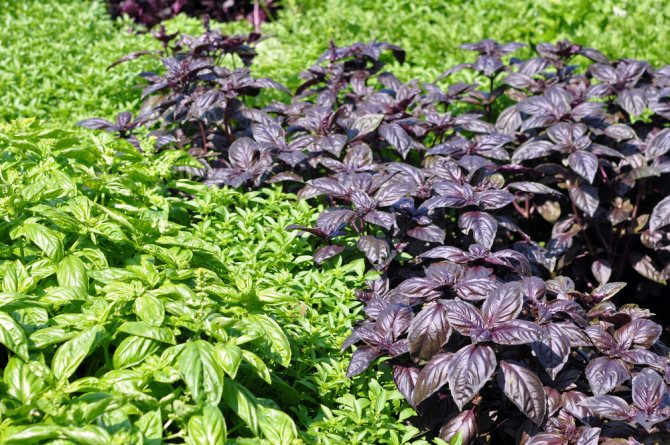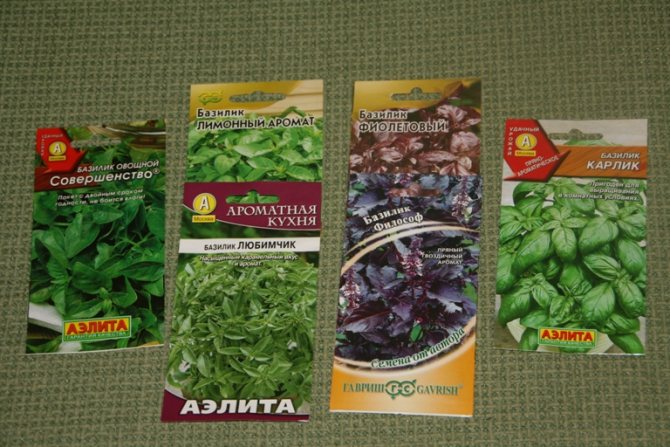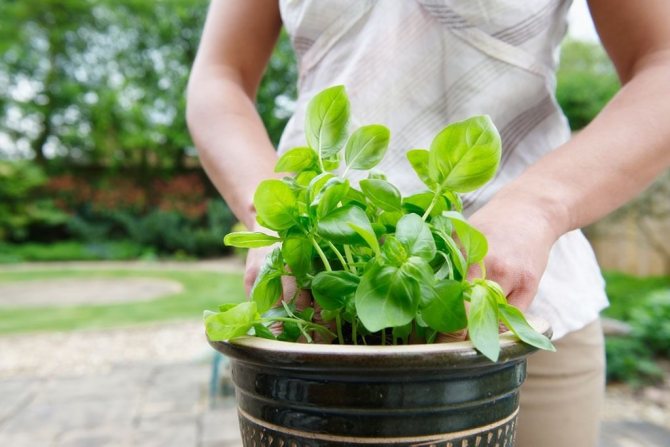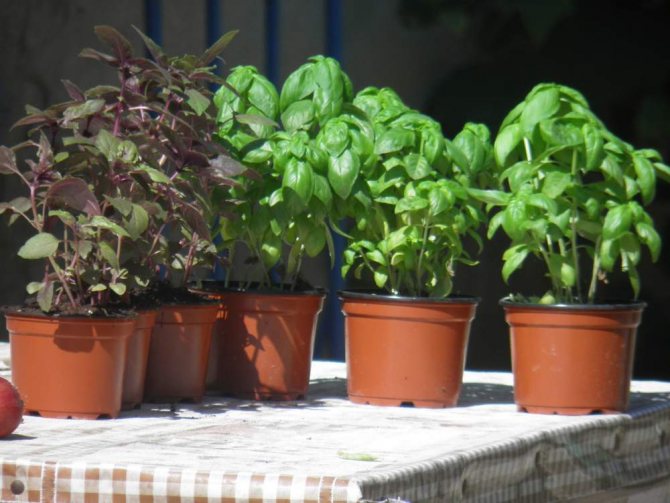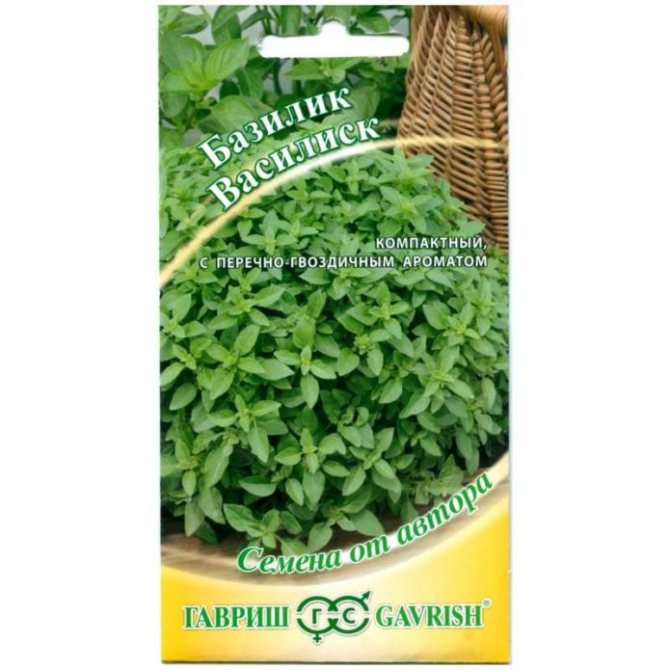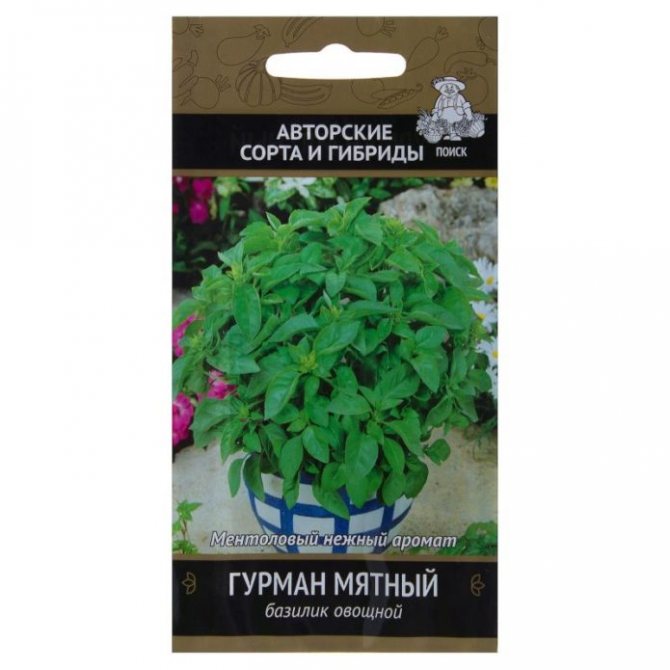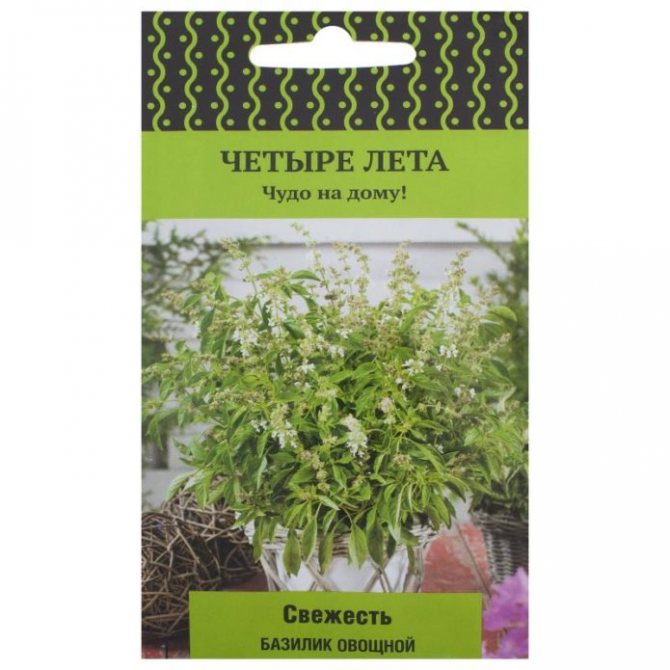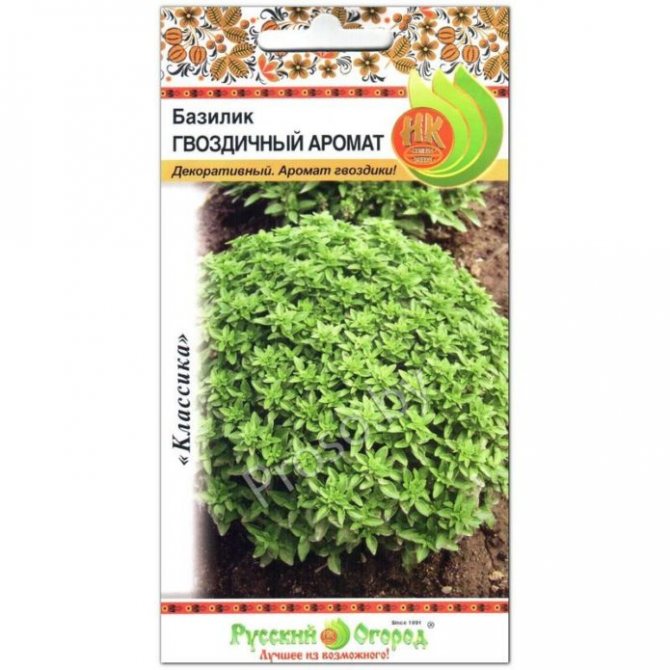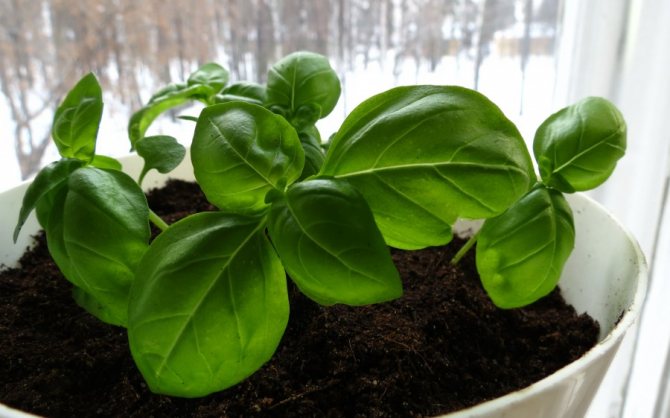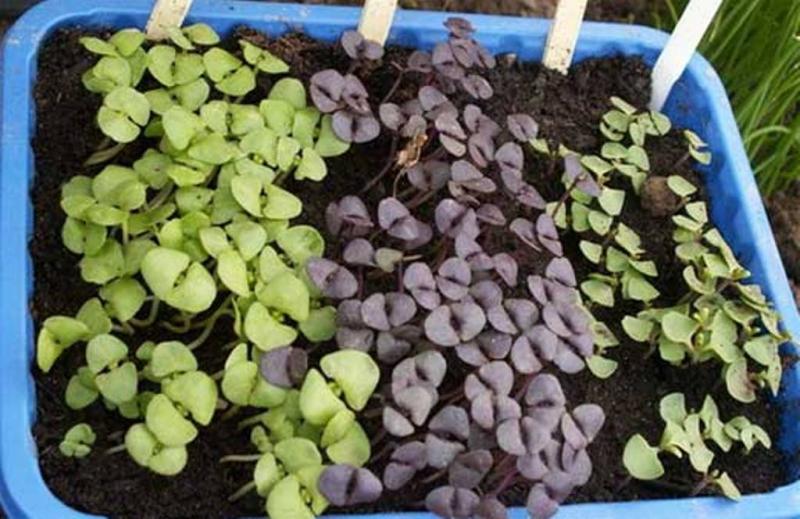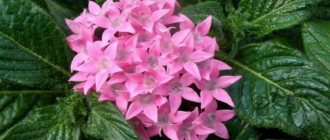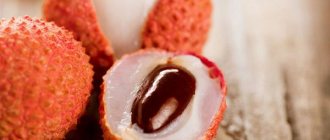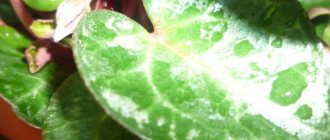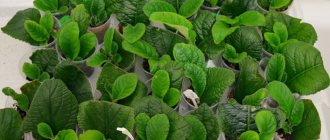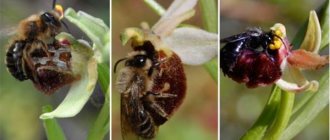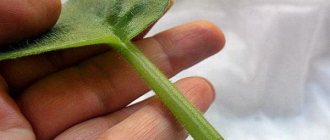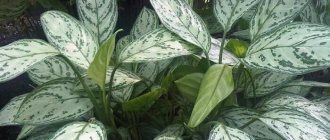There are at least ten types of herbs that grow well on kitchen windowsills. Neat bushes of fresh greenery cheer up, smell delicious and decorate the room, being at the same time a constantly renewable pantry of spices. Basil, which has an exquisite taste and incomparable aroma, is considered an ideal plant for growing on a windowsill. Home-grown basil is in no way inferior to its garden counterparts. So how to grow basil on a windowsill? A few simple tips and growing this scented herb from seeds or cuttings will not be difficult, even for novice gardeners.
[contents]
Unique properties of basil
Basil is widely used in medicine and cooking. It has many positive properties. The plant has an analgesic, antiseptic, bactericidal, diaphoretic, antispasmodic and expectorant effect on the body.
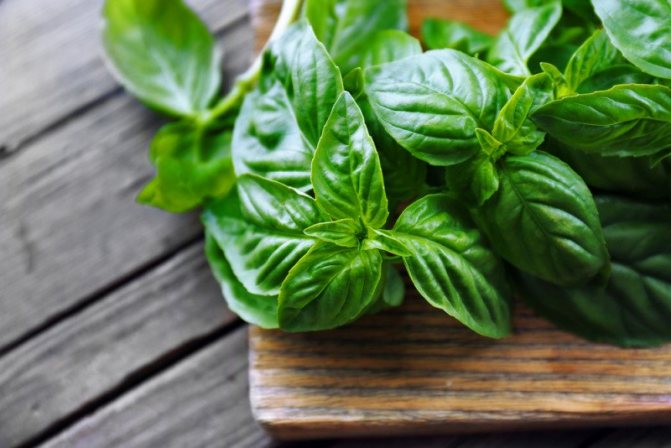
Basil is a versatile home remedy that relieves many symptoms
Basil is used to treat:
- bronchitis;
- asthma;
- tuberculosis;
- urolithiasis;
- hyperemia (an increase in the amount of blood supplied to any part of the body);
- cardiovascular and skin diseases;
- conjunctivitis;
- gastroenteritis;
- rheumatism;
- measles;
- headaches;
- caries;
- tartar and plaque;
- pathologies resulting from radiation damage.
In addition, basil strengthens the immune system well.
Not surprisingly, many growers choose to grow basil in their home. Indeed, the plant contains a large amount of potassium, due to which its use helps to reduce blood pressure.
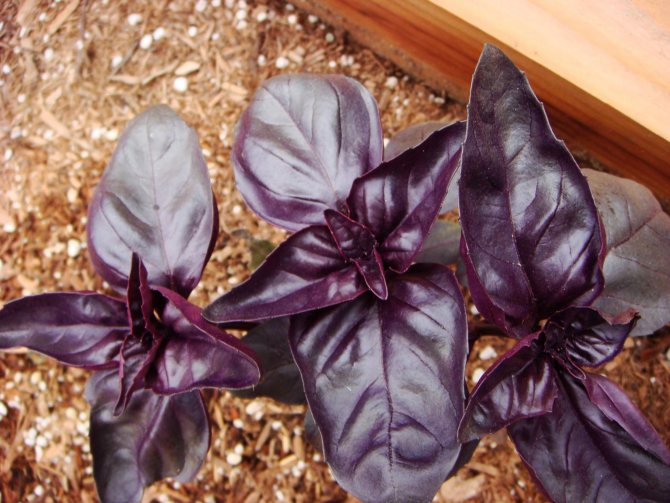

Basil is a healthy and tasty spice
There is a positive effect of basil on the emotional state of a person. The plant helps to reduce stress, reduce feelings of nervousness and anxiety. Vitamin A, C, essential mass and phytonutrients that make up it, rid the body of free radicals and help prolong youth.
However, basil also has negative characteristics. Its overdose can provoke poisoning. When it comes into contact with mucous membranes, the plant causes irritation. Its use is contraindicated during pregnancy, with vein thrombosis and blood clotting disorders. Thus, despite the wide list of positive properties of this plant, it is categorically not recommended to use it without consulting a doctor.
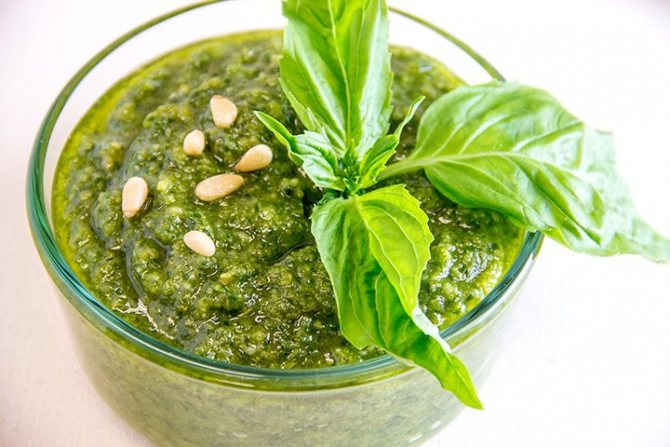

Basil should be used correctly so as not to harm yourself
In cooking, basil is used in the preparation of ketchups, sauces, dressings, gravy, sandwich butter. It is added to products during the smoking and canning process. It improves the taste characteristics of sausages, pates, omelets, salads.
This plant goes well with parsley, tarragon, mint, coriander and marjoram. But it should be borne in mind that basil has a fairly rich aroma that can overpower the smells of other spices. Therefore, use it sparingly.
Recommended varieties for growing on a windowsill


There are many varieties of basil, because many summer residents grow it in the garden and in heated greenhouses. Mostly fragrant species are planted for gastronomic use.Despite the same name, basil varieties differ in their smell and taste, so there are plenty to choose from.
For growing on a windowsill, it is better to give preference to small-leaved varieties, it is easier for them to provide suitable conditions in the house.
For example, such varietal variations of basil are unpretentious:
- Vanilla aroma. Medium early variety. Forms a compact bush with a height of about 30 cm. The leaves are serrated along the edge, oval in shape, with a sharp tip. Blossoms with purple flowers. The plant has a spicy aroma with vanilla notes. Basil grows well with an abundance of light, heat and moisture.
- Baku. Variety of intense purple color with a specific bright aroma. People call it "black basil". Due to the tart taste, in which hints of mint, anise and cloves are perceptible, the spice is perfect for preparing oriental dishes. Bred in Azerbaijan.
- Clove scent. The variety has a pronounced clove aroma, which is reflected in its name. Small green basil leaves are often used in pickling and canning, replacing dry clove buds.
- Yerevan. In this plant, the color of the leaves gives a blue. The aroma of basil mixed the smells of allspice and black tea. The bush looks very decorative at the time of flowering, when soft pink buds bloom on it.
- Purple. Showy plant with dark red leaves. The taste of the leaves is delicate and pleasant. The scent contains notes of pepper and cloves. Vinegar and olive oil are often infused on the leaves of this basil.
Basil is used fresh and dried.
There are also lemon and menthol varieties of spices, used mainly for making drinks ("Lemon", "Lemon aroma", "Velvet").
How to properly transplant an adult plant into a pot on the eve of winter?
Basil transplantation is carried out when growing crops in the open field. In this case, in August or September, the plant must be moved to a pot so that it does not suffer during the cold period. The soil composition is prepared in the same way as when planting cuttings. The volume of the pot should be up to 2 liters.
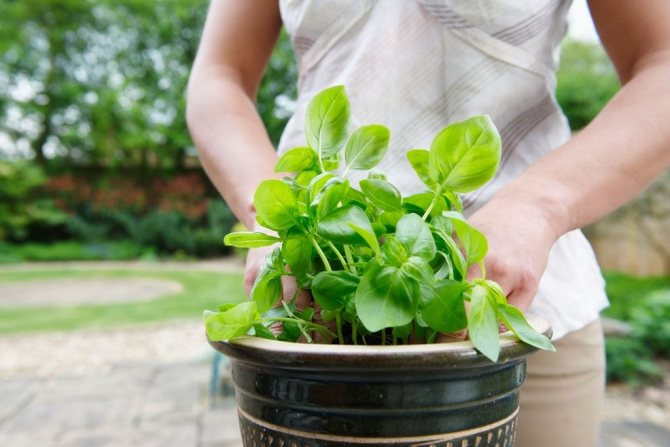

Basil is transplanted to protect against winter frost
The transplant has the following features:
- First, a drainage layer is placed in the pot. Then they fill it with soil, in which a depression is made, where water is poured.
- When the moisture is absorbed, the bush is gently poured in, removed along with the earthen lump and transferred to the pot. In this case, it is necessary to ensure that the roots are not damaged or bent.
- The plant is covered with soil and slightly compacted. If in the process of transplanting some parts of the bush were damaged, they should be cut off.
Preparing for landing
When choosing a container, you should immediately decide how the basil will be grown: by seedlings or cuttings, since the choice of containers depends on this.
Small plastic pallets, low but wide, are suitable for seedlings. As a permanent place of residence, you should choose wide pots with a height of 15 centimeters with a mandatory drain.
Important! Considering that basil requires daily abundant watering, but does not tolerate stagnant water, at least 3 centimeters of drainage material should be placed on the bottom of the pot: expanded clay, fragments of brick or foam.
The cultivation of basil requires a special approach to the choice of soil - the soil should be taken light, fertile and capable of quickly absorbing moisture.


Preparing the basil for planting
The best choice of soil is garden or vegetable garden soil, flavored with humus or compost. You can also use humus mixed with coconut fiber or peat in a 1: 2 ratio.
Culture care
You need to start caring for the plant immediately after removing the film. Timely implementation of all measures will allow to grow a healthy culture.
Watering
Watering the basil depends on the temperature conditions. In warm weather, the procedure is carried out daily. On hot days, the frequency of watering should be 2 times a day. The bushes are moisturized in the morning and at lunchtime using a spray can for this purpose.
The watering rate is determined by the condition of the soil - it should be moderately moist (so that water does not stagnate in the pan of the pot).
It is undesirable to water the plant in the evening. This rule is due to the fact that a cool temperature is set in the room at night. As a result, the evaporation of water from the soil slows down and the likelihood of developing diseases of the bush increases.
Fertilizers
If fertile soil was used when planting the basil, there is no need to feed it, since it is an annual plant with a short growing season.... For the development of the bushes, there will be enough substances introduced initially into the substrate. If the seeds or cuttings were planted in regular garden soil, then the basil should be fertilized once a month.
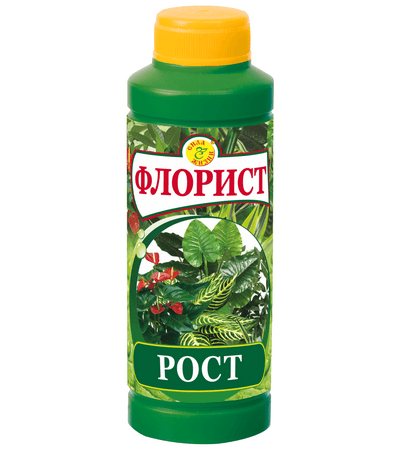

Fertilizer will help the plant to obtain nutrients from ordinary soil.
The plant is watered with a nutrient solution, which is prepared from 2 liters of water and 1 cap of the Growth preparation. Also, Agrolife fertilizer is applied to the upper layer of the substrate (1 tsp per pot).
Pruning
Pruning is done to encourage lateral shoot development. The procedure consists in removing the top of the bush at the level of 6-8 leaves. It is carried out 15–20 days after germination. You should also remove all flowering shoots immediately after they appear. This will enhance the branching of the basil, help preserve the aroma, and help increase the plant's lifespan.
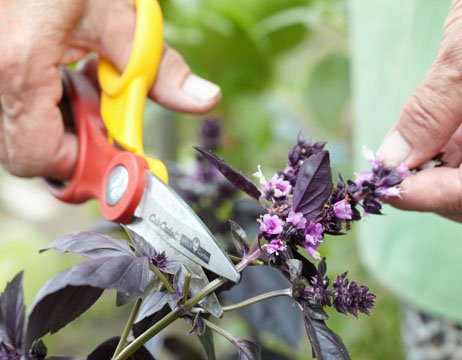

Pruning basil will help it grow in breadth
Other features
- In autumn and winter, it is recommended to wrap the pots with plastic wrap. This will help protect the plant from drafts.
- In the period from October to February, the basilica needs additional lighting in the evening. Lamps are installed at a distance of 20 cm from the bushes.
- On cloudy days, the plant needs artificial lighting.
- Basil can be grown year-round. But in order for the plant to receive a sufficient amount of natural light during the growth period, it is advised to plant in March.
- When the size of the bushes reaches 15 cm, you can harvest. At this stage, the formation of the stem is completed, so the loss of leaves will not affect the development of the basil.
Important! Basil must be protected from drafts.
Reproduction and planting of basil cuttings at home
- For propagation of basil, young shoots or tops of adult basil bushes are cut using cuttings.
- The shoots are placed in a container with water for germination for 1-1.5 weeks. The appearance of roots indicates the readiness of the processes for planting.
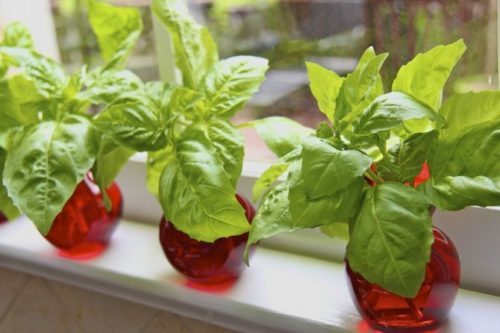

- Sometimes, they practice rooting cuttings directly into the soil substrate, without keeping them in water. Then, the planted cuttings are covered with jars or cut plastic bottles on top. Watering with a root formation stimulator will accelerate the survival rate.
- The cuttings planted in the ground quickly take root and after 2-3 weeks they actively increase the green mass, delighting others with fresh fragrant greens.
- Plants grown in this way will "last" about 3-4 months. After flowering, the leaves, unfortunately, become unusable and lose their aroma.
Pests and diseases
Among the pests, aphids are dangerous. It provokes the appearance of such symptoms:
- the leaves are deformed, lose their color and curl up;
- the growth of the bushes is suspended, and the stems are bent.
As a treatment, spraying with the drug Decis (1 g per 5 l) or Fitoverm (4 ml per 20 l) is carried out. To prevent a pest attack, you must follow the rules of care.
Basil, which is grown at home, is much less likely to suffer from ailments and pests than bushes growing in the open field. But violation of the rules of care can provoke the onset of diseases.
Table: Basil Diseases
| Diseases | Signs of defeat | Control methods | Prophylaxis |
| Fusarium |
| When the first signs appear, spraying the bushes with Topsin-M, Vitaros, Fundazol or Previkur (2 g per 1 liter of water). In case of severe damage, the plant must be destroyed. |
|
| Blackleg |
| Soil treatment with colloidal sulfur (4 g per 1 liter). Spraying basil with Fitosporin solution (4 drops per 200 ml of water). | |
| Gray rot |
| Application of the drug Teldor (5 g per 5 l of water), Alirin-B (2 tablets per 1 l). |
Plant features
Basil is a plant with large, juicy leaves, bright green or purple in color, with a strong smell and rich taste, suitable for year-round cultivation at home. A special feature of the basil is the increased need for heat and light (air temperature 20-22 ° C, long, at least 10 hours, daylight hours), so in winter, to keep the plant in shape, you will have to take care of covering the pots with plantings from drafts and provide additional sources of lighting ...
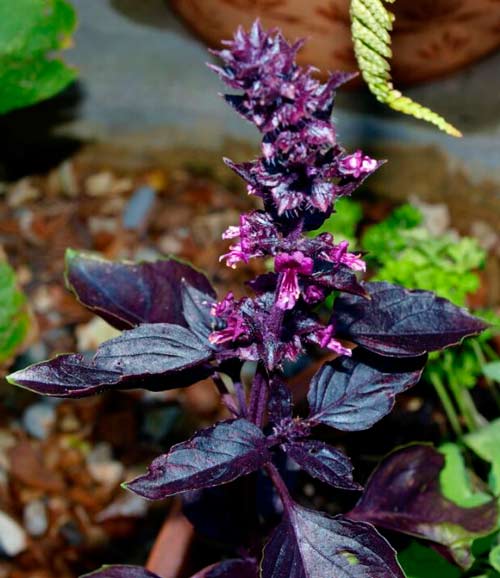

Basil features
Basil is one of the universal spices, whose rich specific taste will suit both meat and fish and salads. Reference! In addition to its undoubted taste, basil is also used in medicine because of its bactericidal properties. It saves for bloating, painful cramps in women, stomach pains, inflammation of the bladder and is simply used to improve digestion.
Common mistakes gardeners make
Mistakes in the cultivation of bushes and harvesting can cause disease and death of the plant. Basil is undesirable to excessively moisturize. When watering, it is necessary to avoid stagnant water.
Some gardeners break off the stems when harvesting. This should not be done as the plant will dry out. You can only collect leaves.
Another mistake is tearing off the basil. This can damage the stem. Therefore, the leaves should be cut off with scissors.
When growing basil, take into account its need for warmth and good lighting. It must also be remembered that the plant does not tolerate excessive watering and drafts. Compliance with these rules will help to grow this tropical crop on the windowsill and get a good harvest.
Varieties
When wondering how to grow basil on a windowsill, you should start by choosing a variety. In specialized stores, you can find many seeds of various varieties, differing in the shape of the leaves, color, shades of spicy aroma. The following varieties of basil are optimal for planting at home:
- Vietnamese, with a sweet taste and strong aroma, ideal for a variety of salads;
- lemon, containing a special aromatic substance citral, which gives the plant the smell of fresh lemon;
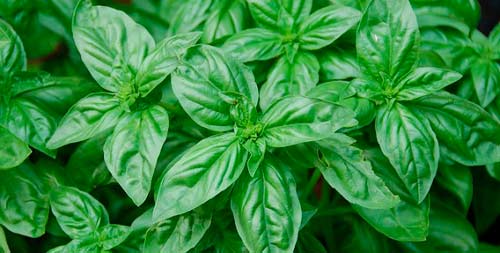

Lemon basil
- purple, which is an excellent decoration both in the salad and on the windowsill.
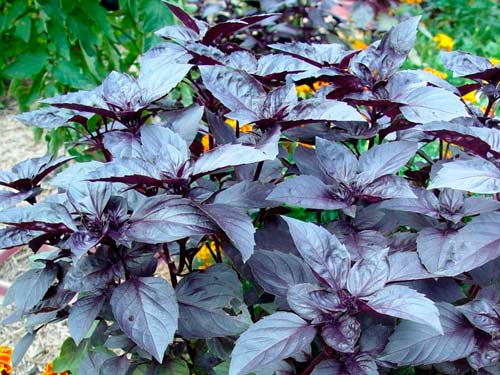

Basil purple
For permanent planting, it is worth using perennial varieties, such as, for example, African basil with exquisite blue veins or Thai basil.
Optimal timing for sowing
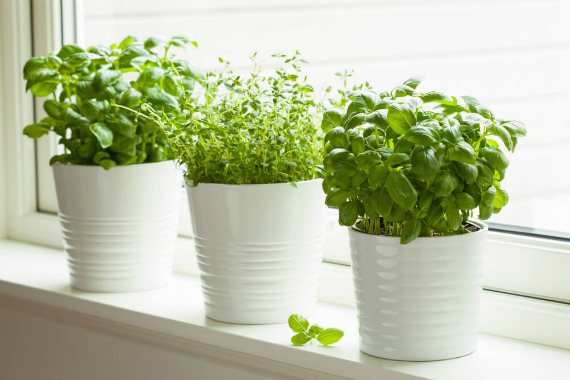

Basil can be grown on the windowsill at any time of the year, but crops will grow best if planted in March-April.
On a light window, you can plant a plant with seeds at the end of February. In order for the bushes to develop quickly and remain healthy, coordinate the planting time with the lunar calendar. The waxing moon will give the basil a good start for growth.
Possible problems with seedlings and their solutions


Things don't always go smoothly when growing basil at home. Problems can lie in wait at the very early stages of seedling development:
- The seed coat does not come off. Sometimes this can cause the death of seedlings, because the adhering film prevents them from developing normally.
This often happens when the seeds are planted too deep. The reason may also be the high looseness of the soil. The “caps” must be removed in order to release the sprouts. Moisten them with water every 3-4 hours, and then gently pry with a toothpick or needle and remove.
- Low germination. Didn't the basil seeds germinate, or did they partially germinate? This could be due to deep seeding or the use of old seed. Try re-sowing the spice in a more superficial way. Use fresh seeds.
- Some of the sprouts died. Most likely, the reason is a dangerous fungal infection - "black leg". It is necessary to disinfect the seeds and soil themselves before sowing, do not be zealous with watering.
If trouble has already occurred, the affected seedlings are removed from the container along with a lump of earth and thrown away. The remaining seedlings are watered with a fungicide solution (Fundazol, Topsin). The sprouts can also lie down due to insufficient, surface watering. When moistening, it is necessary to soak the ground completely, to the bottom.
- Growth retardation after picking. The reason is root damage during transplantation. Tamp the soil in the pot so that it adheres more closely to the roots. This will cause additional roots to grow and the seedlings will recover faster.
- Burns appeared on the leaves. In spring and summer, seedlings can suffer from the bright sun, plants should be taught to it gradually. As an emergency, spray the basil with Epin's solution and arrange shading.
- The seedlings are stretched out. The reason may be a lack of light, thickened plantings, excess nitrogen and a lack of other minerals. Increase lighting, reduce watering, cut seedlings urgently, apply balanced fertilizer.
If you provide the plants with suitable conditions, they will not cause unnecessary trouble. The earlier signs of abnormalities are noticed, the better. The measures taken in time will quickly return the seedlings to a healthy appearance.
Growing basil from seeds step by step
Choose the most well-lit windowsill in your apartment for keeping the basil. This subtropical plant loves bright light, there cannot be an excess of sunlight for it.
Start with simple, unpretentious varieties. With a successful experience, you will be able to grow the varieties that you want in the future.
And of course, growing basil from seeds, you should be patient, because the growing season in this case takes a lot of time.
Soil preparation
For planting, you can use soil purchased from a gardening store. It is permissible to plant basil in your own prepared soil mixture.
For example, you can take regular garden soil and add some river sand to it. Some make up a substrate of 1 part sand and 2 parts peat. The soil should be fertile and loose in structure.
The purchased land does not need to be disinfected, it has already been processed. If you prepare it yourself, you will need to disinfect it by steaming in the oven. For this purpose, you can also use a hot solution of potassium permanganate, they spill the soil a few days before planting.
Seed preparation for sowing


To speed up the germination process, the seeds can be allowed to swell.
- To do this, they are placed in warm water for 1-2 days.
- As the water cools down, it is replaced with warmed water.
- After that, it is advisable to process the seeds with potassium permanganate.
- Soaking for 2 hours in a light pink solution of potassium permanganate will help protect the seedlings from various diseases.
- After finishing the treatment, the seeds are washed in clean water and slightly dried before sowing to prevent them from sticking together.
Choice of capacity
The choice of container for planting depends on the growing method. You can plant seeds in small cups and then dive them into larger containers. If you do not have the desire to once again engage in transplanting, immediately take medium-sized pots - for 2-3 plant specimens, such a container will be enough.
It is preferable if the containers for planting are made of plastic. They are easy to wash and disinfect, and the roots when grown in winter in such a container will not be cold. You can use an elongated plastic container for planting, planting several bushes of herbs in it at once, planting seeds in a row.
How to plant basil seeds
You can grow basil in a pot from cuttings or from a young shoot from a garden, but basil grown from seeds gives the best and longest time (almost a year!) At home.
To plant basil on a windowsill, you will need:
- Seeds;
- Basil varieties will work either, but keep in mind that purple and Greek small-leaved varieties take longer and harder to grow. Small-leaved and undersized varieties of basil grow especially quickly and easily.
- Soil (for more information on soil selection and preparation, see Step # 2);
- Expanded clay or pebbles for drainage;
- A pot with a volume of 1-2 liters or a large container with a depth of at least 15 cm, in which the basil shoots can grow at a distance of 10 cm from each other. The container for growing basil must have drainage holes;
- Cling film or plastic bag;
- Scapula.
Read also Photo of the forest in winter in good quality
Step 1. Seed preparation
This stage is optional, but desirable if you want to slightly speed up the appearance of the first shoots. Soak the seeds in warm water for 1-2 days, changing the water every 12 hours (or more often), then soak them in a slightly pink solution of potassium permanganate for 2 hours and finally dry the seeds on a napkin or gauze. You can catch the seeds with a toothpick.
Step 2. Preparing the soil
Loose soil is an important condition for success. Suitable soil can be created from:
- A mixture of universal soil for indoor plants with garden soil (in a 1: 1 ratio);
- A mixture of vermicompost and soil for indoor plants (in a ratio of 1: 4);
- Mixtures of vermicompost with coco-soil (in a ratio of 1: 2).
Do not forget to treat the purchased soil before planting the seeds: pour it onto a baking sheet and bake it in the oven at a temperature of 100-120 degrees for about an hour, and then feed it with any mineral fertilizer. This procedure will prevent future pests from emerging.
Next, put expanded clay or pebbles on the bottom of the container so that a drainage layer 2-3 cm thick is obtained.Finally, pour the prepared soil on top, not reaching 3-4 cm to the edges, level the surface, and then water the soil abundantly.
Step 3. Sowing seeds
Now you need to sow the seeds at a distance of about 2 cm from each other, sprinkle them with a 1-2 cm layer of earth, and then cover the pot with cling film or a bag to create a greenhouse effect.
- Step 4. Create favorable lighting
If you grow basil in the fall or winter (from September to February), then your mini-vegetable garden must be artificially illuminated for 12 hours a day. - Fitolamps or LED lamps with warm white light 2700K, installed at a distance of 15-20 cm from the plants, are suitable for this.
Step 5. Correct harvest
The key to getting fluffy and branched with lots of basil leaves is pruning frequently and early, also known as pinching.
After 1-1.5 months, when the basil is overgrown with 4-6 true leaves, you need to harvest the first harvest by pinching off 2 leaves from the tops.
Further, when the basil acquires 3 sets of real leaves, you need to pinch its top immediately, cutting off the stem just above the small leaves that are just starting to grow from the sinuses. The place of the cut and those very small, barely noticeable leaves can be seen in the photo below. This procedure should be done every few weeks.
- When you only need a few leaves here and there to add to a dish or drink, select the older side leaves and pinch them off where they meet the main stem (shown in the photo).
- Remember that plants should always have at least 4 leaves at the bottom. If you prune the lower shoots, the basil will start to grow taller rather than wider and will be less productive.
- If you see a bud in bloom, immediately cut it off and the two leaves below it. If this is not done, the greens will start to deteriorate.
We offer you to watch an illustrative video tutorial on growing basil on a windowsill.
Sowing dates for basil seedlings
There are varieties of different ripening periods. But the growing season for a plant is 120-160 days. It should be planted on ridges after the onset of warm weather. The soil should warm up.
Seedlings should be driven out 50-60 days before the intended placement in a permanent place. According to the calendar, it is March 20-25.
When grown in an unheated greenhouse, seedlings can be planted when sunny weather approaches. Ultraviolet light is enough to warm up the protected ground. Then it is recommended to sow a month earlier.


Planting capacity and soil for basil
For growing a basil bush at home, long wooden containers or elongated clay flower pots are ideal, the main thing is that they are sufficiently voluminous, since the root system grows abundantly.
It is best to warm up the soil before planting and fertilize with mineral fertilizing or humic concentrate.
The container chosen should be well drained to prevent fluid stagnation. For planting this plant, black soil and sandy loam are suitable.
How to prepare the soil and the pot?
Basil needs a loose substrate. For sowing seeds, you can purchase ready-made soil for seedlings or mix vermiculite, perlite and peat in equal parts. The soil should be poured onto a baking sheet and kept in the oven for about an hour at a temperature of +100 to + 120 ° C. Or, a day before sowing, disinfect the soil with a fungicide. Then spill with mineral fertilizer: 1/8 teaspoon of superphosphate, potassium sulfate and urea per liter of water.
For sowing seeds, containers no higher than 10-15 centimeters are suitable. A prerequisite is the presence of a drainage hole at the bottom. If the pot is old, it must be washed and treated with a solution of potassium permanganate. Cuttings require deep containers at least as high as the cuttings themselves. For planting seedlings, choose pots with a volume of at least two to three liters for each bush. Expanded clay, pebbles or broken bricks are used as drainage.
Harvesting
The first basil greens can be obtained 1-1.5 months after sowing the seeds. To make the plant at home on the windowsill lush and branch well, you need to regularly pinch off 1-2 side leaves. For the first time, this can be done when 4 adult leaves appear on the bush. When the plant acquires 6-8 leaves, pinch its top, thus ensuring the development of lateral shoots. This procedure is done every 2-3 weeks. Lateral shoots are also pinched at the point of growth behind the third pair of leaves.
At least 4 lower leaves must be left on each plant, since new shoots will subsequently form in their axils. If you cut them off, the plant will tend to grow up, and not in breadth, and a beautiful lush bush will not work.In addition, its yield will decrease significantly.
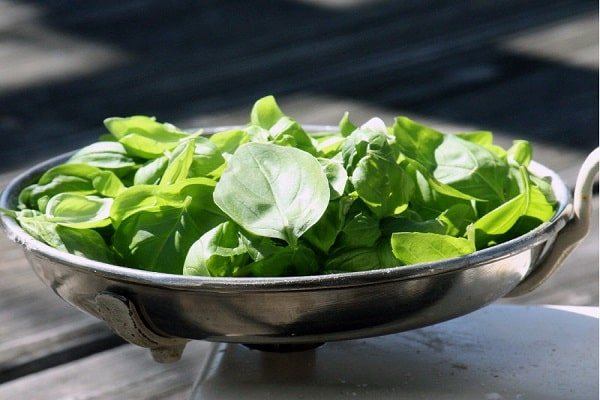

When the first buds appear, they are immediately removed along with the two lower leaves. If this is not done, the basil will lose its taste, become tough and unsuitable for food.


